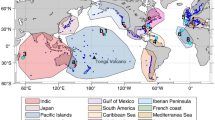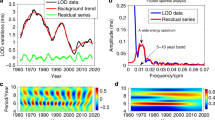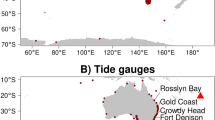Abstract
IN an earlier paper1 the authors reported the recording and analysis of the gravity variation with time in the month of December, 1961, at Hyderabad (long. 78° 27′ E and lat. 17° 26′ N). The record was continued for another six months in 1962 and the data were analysed only for the main lunar semidiurnal tidal component M2 as it was found that this was the most consistent and dependable component. It is found desirable to check the calibration of the photographic recording paper (in milligals) frequently. The theoretical amplitude is 0.069 milligals for Hyderabad.
This is a preview of subscription content, access via your institution
Access options
Subscribe to this journal
Receive 51 print issues and online access
$199.00 per year
only $3.90 per issue
Buy this article
- Purchase on Springer Link
- Instant access to full article PDF
Prices may be subject to local taxes which are calculated during checkout
Similar content being viewed by others
References
Balakrishna, S., and Lakshmi, B. R., Nature, 198, 1079 (1963).
Author information
Authors and Affiliations
Rights and permissions
About this article
Cite this article
BALAKRISHNA, S., LAKSHMI, B. M2 Component at Hyderabad. Nature 204, 774–775 (1964). https://doi.org/10.1038/204774b0
Issue Date:
DOI: https://doi.org/10.1038/204774b0
This article is cited by
-
M2 and S2 Tidal Components at Hyderabad
Nature (1966)
Comments
By submitting a comment you agree to abide by our Terms and Community Guidelines. If you find something abusive or that does not comply with our terms or guidelines please flag it as inappropriate.



